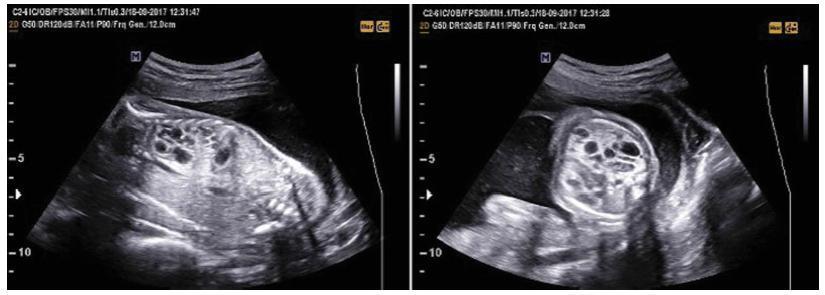Summary
Revista Brasileira de Ginecologia e Obstetrícia. 2019;41(12):682-687
The present study aims to understand to what extent obesity is related to adversematernal, obstetrical, and neonatal outcomes in a Portuguese obstetrical population.
A retrospective case-control study was conducted at the Department of Obstetrics of a differentiated perinatal care facility. The study compared 1,183 obese pregnant womenwith 5,399 normal or underweight pregnantwomen for the occurrence of gestational diabetes, hypertensive pregnancy disorders, and preterm birth. Mode of delivery, birthweight, and neonatal intensive care unit (ICU) admissionswere also evaluated. Mean blood glucose values were evaluated and compared between groups, in the first and second trimesters of pregnancy. Only singleton pregnancies were considered.
The prevalence of obesity was 13.6%. Obese pregnant women were significantly more likely to have cesarean sections (adjusted odds ratio [aOR] 2.0, p< 0.001), gestational diabetes (aOR 2.14, p< 0.001), hypertensive pregnancy disorders (aOR 3.43, p< 0.001), and large-for-gestational age ormacrosomic infants (aOR 2.13, p< 0.001), and less likely to have small-for-gestational age newborns (aOR 0.51, p< 0.009). No significant differences were found in terms of pretermbirths, fetal/neonatal deaths, low birthweight newborns, and neonatal ICU admissions among cases and controls. Maternal obesity was significantly associated with higher mean blood glucose levels, in the first and second trimesters of pregnancy.
Obesity is associated with increased risks of adverse pregnancy and neonatal outcomes. These risks seem to increase progressively with increasing body mass index (BMI) class. Female obesity should be considered a major public health issue and has consequences on maternal-fetal health.
Summary
Revista Brasileira de Ginecologia e Obstetrícia. 2019;41(11):654-659
To evaluate the outcomes of cases of prenatally-diagnosed congenital pulmonary airway malformation (CPAM).
We retrospectively evaluated cases of prenatally-diagnosed CPAM between 2004 and 2018. Ultrasonographic features such as visualization of a fetal lung mass and heterogeneous pulmonary parenchyma were used for CPAM diagnosis. Prenatal and postnatal findings were compared in terms of accuracy regarding the CPAM diagnosis.
The sample consisted of 27 cases. There were four cases in which the patients opted for the termination of pregnancy due to the severity of the lesion. A total of 23 neonates were delivered, and CPAM was confirmed in 15 cases. Themedian gestational age at delivery was 37 weeks (28-40 weeks) and the mean birth weight was 2,776 g. There were two neonatal deaths, one due to pneumothorax, and the other due to hypoplastic left heart syndrome (HLHS). A total of five patients with respiratory problems were operated in the postpartum period. There were eight misdiagnosis: bronchopulmonary sequestration (five cases), congenital lobar emphysema (two cases), and congenital diaphragm hernia (one case).
A precise postnatal diagnosis is very important to organize the proper management of the pregnancies with fetuses with CPAM. The positive predictive value of the prenatal diagnosis of CPAM via ultrasonography is of 70.3%. The differential diagnosis of CPAM may be prolonged to the postpartum period in some cases.

Summary
Revista Brasileira de Ginecologia e Obstetrícia. 2019;41(11):647-653
The present study aims to compare the maternal and fetal outcomes of parturients with and without a gestational diabetes diagnosis.
A case-control study including parturients with (cases) and without (control) a gestational diabetes diagnosis, who delivered at a teaching hospital in Southern Brazil, between May and August 2018. Primary and secondary data were used. Bivariate analysis and a backward conditionalmultivariate logistic regression were used to make comparisons between cases and controls, which were expressed by odds ratio (OR), with a 95% confidence interval (95%CI) and a statistical significance level of 5%.
The cases (n=47) weremore likely to be 35 years old or older compared with the controls (n=93) (p<0.001). The cases had 2.56 times greater chance of being overweight (p=0.014), and a 2.57 times greater chance of having a positive family history of diabetes mellitus (p=0.01). There was no significant difference regarding weight gain, presence of a previous history of gestational diabetes, height, or delivery route. The mean weight at birth was significantly higher in the infants of mothers diagnosed with diabetes (p=0.01). There was a 4.7 times greater chance of macrosomia (p<0.001) and a 5.4 times greater chance of neonatal hypoglycemia (p=0.01) in the infants of mothers with gestational diabetes.
Therefore, maternal age, family history of type 2 diabetes, obesity and pregestational overweightness are important associated factors for a higher chance of developing gestational diabetes.
Summary
Revista Brasileira de Ginecologia e Obstetrícia. 2019;41(11):636-646
To determine the prevalence of episiotomy and the factors associated with the knowledge, attitude and practice (KAP) of Brazilian obstetricians in relation to this procedure.
A KAP survey was conducted with obstetricians working in Brazil. An electronic form containing structured questions previously evaluated using the Delphi method was created in Google Docs and sent by e-mail. A multivariate logistic regression was performed to determine the principal factors associated with adequate KAP. For each dependent variable (knowledge, attitude and practice) coded as adequate (1 = yes; 0 = no), a multiple logistic regression model was developed. Binary codes (1 = yes and 0 = no) were assigned to every independent or predictor variables. Prevalence ratios (PRs) and their respective 95% confidence intervals (95%CIs) were calculated as measures of relative risk, at a significance level of 5%.
Out of the 13 thousand physicians contacted, 1,163 replied, and 50 respondents were excluded. The mean episiotomy rate reported was of 42%. Knowledge was determined as adequate in 44.5% of the cases, attitude, in 10.9%, and practice, in 26.8% of the cases.
Most respondents had inadequate knowledge, attitudes and practices regarding episiotomy. Although some factors such as age, teaching, working in the public sector and attending congresses improved knowledge, attitude and practice, we must recognize that episiotomy rates remain well above what would be considered ideal. Adequate knowledge is more prevalent than adequate attitude or practice, indicating that improving knowledge is crucial but insufficient to change the outlook of episiotomies in Brazil.
Summary
Revista Brasileira de Ginecologia e Obstetrícia. 2019;41(11):673-678
To evaluate whether the use of intraoperative ultrasound leads to more conservative surgeries for benign ovarian tumors.
Women who underwent surgery between 2007 and 2017 for benign ovarian tumors were retrospectively analyzed. The women were classified into two groups: those who underwent intraoperative ultrasound (group A) and those who did not (group B). In group A, minimally-invasive surgery was performed for most patients (a specific laparoscopic ultrasound probe was used), and four patients were submitted to laparotomy (a linear ultrasound probe was used). The primary endpoint was ovarian sparing surgery (oophoroplasty).
Among the 82 cases identified, only 36 met the inclusion criteria for the present study. Out of these cases, 25 underwent intraoperative ultrasound, and 11 did not. There were no significant differences in arterial hypertension, diabetes, smoking history, and body mass index for the two groups (p=0.450). Tumor diameter was also similar for both groups, ranging from 1 cm to 11 cm in group A and from 1.3 cm to 10 cm in group B (p=0.594). Tumor histology confirmed mature teratomas for all of the cases in group B and for 68.0% of the cases in group A. When the intraoperative ultrasound was performed, a more conservative surgery was performed (p<0.001).
The use of intraoperative ultrasound resulted in more conservative surgeries for the resection of benign ovarian tumors at our center.

Summary
Revista Brasileira de Ginecologia e Obstetrícia. 2019;41(8):500-507
The present study was conducted with the objective of investigating the effectiveness of solution-focused group counseling (SFGC) on promoting the mental health of midwifery students.
The present study is an intervention-based study with a pretest, a post-test, and a control group. The statistical population included all of the midwifery students studying in the midwifery department of the Bam University of Medical Sciences, Kerman, Iran, who filled out the General Health Questionnaire (GHQ) in the screening phase. In the second phase, 40 individuals, having a low level of mental health based on the cutoff score of 23, were selected and randomly divided into 2 groups (intervention and control), each group with 20 participants. The intervention group participated in 5 sessions of 75 minutes for SFGC. Then, the post-test was held in both groups and the data analysis was conducted using the Mann-Whitney and the Kruskal-Wallis test with IBM SPSS Statistics for Windows, Version 21.0 (IBM Corp, Armonk, NY, USA). The significance level was considered as p < 0.05.
The findings showed that the mean of the post-test mental health scores of the intervention group (14.5 ± 50.35) and of the control group (23.6 ± 35.83) showed a statistically significant difference (p < 0.0001). Moreover, the comparison between the mean scores of the mental health subscales (physical symptoms, stress, social performance, and depression) showed a statistically significant difference in these groups, and SFGC improved physical symptoms, stress, social performance, and depression in the members of the intervention group.
Solution-focused group counseling may improve all levels of mental health. This type of counseling is recommended to be used to solve the psychological problemsand to improve the mental health of students, as well as of the staff of the health system.
Summary
Revista Brasileira de Ginecologia e Obstetrícia. 2019;41(8):493-499
To compare the Latin American and European assisted reproductive technology (ART) registries regarding data accessibility and quality, treatment utilization, effectiveness, safety, and quality of services.
We performed an ecological study using data from scientific publications of Latin American and European registries that report cycles initiated during 2013 (the most recent registries available until December of 2017). The summarized data are presented as frequencies, percentages, minimum-maximum values, and absolute numbers.
Reporting clinics and cycle treatments were unevenly distributed between the participating countries for both registries, although access to ART is 15 times greater in Europe. In Latin America, individual services participate voluntarily reporting started cycles until cancellation, birth or miscarriage, while in Europe it varied among countries. It makes the data available from Latin America more uniform, although lesser representative when compared with European ones, given that reporting is compulsory formost countries. The cumulative live birth rate was better in Latin America. Female age, use of intracytoplasmic sperm injection (ICSI), cycles with transfer of ≥ 3 embryos, as well as multiple pregnancy rates were greater in the Latin American Register of Assisted Reproduction (RLA, in the Portuguese acronym). Assisted reproductive technology complications, such as ovarian hyperstimulation syndrome, hemorrhage, and infections were also higher in LatinAmerica, although they are extremely uncommon in both regions.
Both regions have points to improve in the quality of their reports. Latin America has produced a more uniform reporting, their clinical results are generally